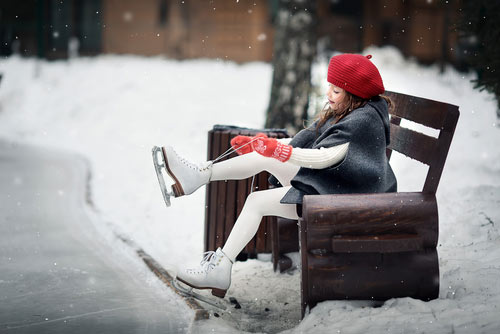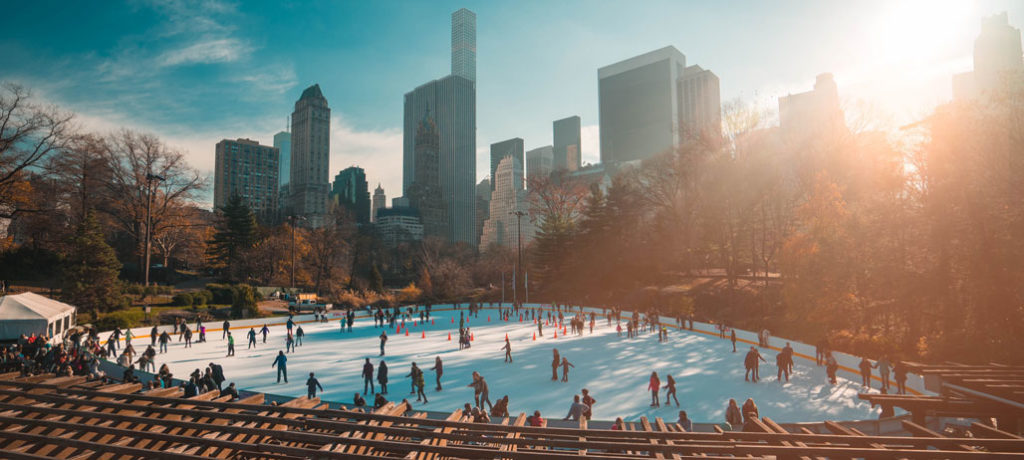Manhattan Locations to Lace Up Your Skates
Sky
Rink at Chelsea Piers
Location: 61 Chelsea Piers, New York, NY 10011
Phone: 212-336-6100
Website: www.chelseapiers.com/sr/general-skating
The
Rink at Bryant Park
Location: Midtown Manhattan, between 40th and 42nd
Streets and Fifth and Sixth Avenues
Contact: Bryant Park Corporation, 1065 Avenue of
the Americas, Suite 2400, NY, NY 10018
Phone: 212-768-4242
Website: https://bryantpark.org/amenities/the-rink
Wollman Rink in Central Park(cash only)
Location: Central Park,830 5th Avenue (at East Dr.), New York, NY 10065
Phone: 212-439-6900
Website: www.wollmanskatingrink.com
The Rink at Rockefeller Center
Location: 600 5th Avenue, New York, NY 10020
Phone: 212-332-7654
Website: https://therinkatrockcenter.com
The evolution of ice skating in Central Park
You may not like cold weather, but one ancient invention continues to make it a little easier for us to glide through the winter months. Whether we hold our breath while we watch a figure skater execute a perfect triple Lutz, leap out of our seat when our favorite hockey player scores a hat trick, or lace up a pair of skates and take a few laps around a frozen pond, skating has a lengthy history of helping people warm up to winter.
EXPLORE GREENWICH VILLAGE IN THE WINTER
Click here for A family-friendly, cold weather guide to exploring all things Greenwich Village, indoors and out.
Historians agree skating started out being more functional than fun.
Thanks to archeological evidence, the origin of the ice skate is widely believed to have occurred sometime around 1000 BCE. At the time, winter in Northern European regions came with an abundance of ice, leftover animal bones, and cold hunter-gatherers looking for a faster way to get to where they were going.
How ice skating began
Strapping leftover game to bones on their footwear was the most efficient means of transporting food, decreasing the time it took to traverse frozen lakes, rivers and streams. From fire to forge, bones were eventually replaced with metal, and ongoing changes in boot and blade designs specific to a skate’s function greatly improved efficiency.
According to Smithsonian.com, by the
Historical records and period artwork also indicate that at some point, commuters discovered that the activity was actually fun. Recreational skating is still big in the Netherlands and
Eventually, the recreational sport made its way across the English Channel.
Olympic.org reports that at this time, skating clubs and man-made rinks emerged and ice skating became a favorite pastime of British royalty. Olympic.org also notes that, although hockey had origins as an ancient ball and stick game on turf, the venue eventually moved to ice, with hockey clubs and organizations forming in England as early as 1861.
Skating continued to evolve “across the pond” in North America, and by 1850 Philadelphia’s Edward Bushnell improved upon the blade by replacing previously wooden footplates with steel, greatly increasing a skater’s range of motion.

By 1860, the additional maneuverability of steel allowed a New York-born, European ballet master named Jackson Haines to successfully introduce aspects of ballet and dance to skating. This may be the greatest
According to USfigureskating.org, in 1863 and 1864, Haines went on to win the Championships of America, known today as the U.S. Figure Skating Championships. Swift on the figure skater’s heels, Wikipedia.org credits Canada for developing the modern day sport of ice hockey, with the first indoor game being played in Montreal in 1875.
Ice skating surged in popularity in the early 1900s when 11-year-old Norwegian Sonja Henie made her Olympic debut in 1924 at Chamonix in France. Her prowess led to Hollywood success in a series of films in the 1930s and early 1940s featuring her talents. Her 1936 film debut was in “One in a Million.” (Check out her performance on YouTube.com)
Ice skating remains a popular winter activity in New York



